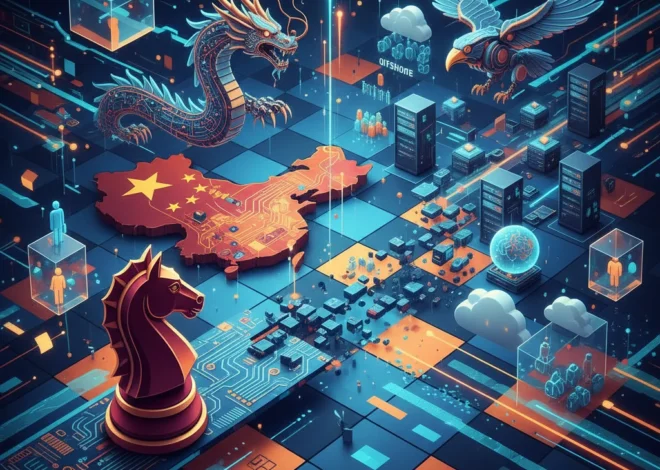
AI’s New Cold War: Why Geopolitics is Freezing the Tech Deal Market
We’re living through the biggest gold rush in modern history: the artificial intelligence boom. Companies like Nvidia are reaching trillion-dollar valuations, and every startup is scrambling to pivot its pitch deck to include “AI-powered.” The promise is a new era of explosive growth, boundless innovation, and a complete reshaping of the global economy. It feels like the dot-com boom on steroids, a tidal wave of capital chasing the next world-changing algorithm.
But beneath the glossy surface of this AI frenzy, a very different story is unfolding. A story of closed borders, nationalistic ambitions, and deep-seated economic anxiety. The AI revolution isn’t happening in a peaceful, globalized world. It’s happening on a geopolitical chessboard, and the moves being made by world powers are creating shockwaves that threaten to freeze the very dealmaking engine that fuels the tech industry. The much-anticipated rebound in tech mergers and acquisitions (M&A) is looking less like a recovery and more like a mirage, clouded by the fog of a new tech cold war.
The Great Decoupling: When Code and Chips Have Passports
For decades, the tech world operated on a simple premise: build the best product, and the world will be your market. A developer in Bangalore could collaborate on a project with a team in Silicon Valley, using servers hosted in Ireland. This borderless digital nation was the engine of modern innovation. That engine is now sputtering.
The primary conflict, of course, is the escalating tech rivalry between the United States and China. This isn’t just about tariffs or trade imbalances; it’s a fundamental battle for technological supremacy. The most visible front in this war is the battle over semiconductors—the advanced chips that are the lifeblood of modern artificial intelligence. The U.S. has implemented stringent export controls, effectively cutting off China’s access to the most powerful AI chips from companies like Nvidia and the advanced manufacturing equipment needed to make them.
This has triggered a global scramble for “technological sovereignty.” Nations no longer want to be dependent on a rival power for the foundational technology of the 21st century. We’re seeing the rise of “sovereign AI,” a push by countries to build their own large language models (LLMs), control their own data, and secure their own supply of computing power. According to the Financial Times, governments from the UAE and Saudi Arabia to France and Japan are pouring billions into creating “national champion” AI companies (source). France’s Mistral AI, for example, achieved a multi-billion dollar valuation in record time, largely on the promise of creating a European alternative to US-based models.
For startups and developers, this new reality is a minefield. The hardware you use for programming your machine learning models, the cloud provider you choose, and even the nationality of your investors are now all subject to geopolitical scrutiny. The dream of a single, global tech ecosystem is fading, replaced by a fragmented world of competing digital blocs.
The M&A Mirage: Big Checks for a Few, Crickets for the Rest
With so much money flowing into AI, you’d expect the tech M&A market to be on fire. The logic seems simple: big tech companies, flush with cash, should be snapping up innovative AI startups to gain a competitive edge. Investment bankers have been hopefully predicting a “rebound” for over a year. Yet, the reality on the ground is starkly different.
While a handful of foundational model companies like OpenAI and Anthropic have raised staggering sums at eye-watering valuations, the broader market for tech deals remains sluggish. The overall volume of tech M&A is still far below its recent peaks, with many deals falling apart over valuation gaps and intense regulatory scrutiny as reported by industry analysts. The AI boom isn’t lifting all boats; it’s creating a highly concentrated market where a few “chosen ones” attract nearly all the capital, while thousands of other high-quality software and SaaS companies struggle to find buyers.
Let’s look at the disconnect between the hype and the market reality. While private funding for generative AI has skyrocketed, the overall health of tech M&A tells a different story.
| The AI Hype (Concentrated Capital) | The M&A Reality (Sluggish Market) |
|---|---|
| Massive, multi-billion dollar funding rounds for a few foundational model startups (e.g., OpenAI, Anthropic, Mistral). | Overall tech M&A volume remains depressed compared to 2021-2022 highs. |
| Sovereign Wealth Funds investing heavily in “national champion” AI companies to ensure geopolitical relevance. | Increased antitrust and regulatory reviews from bodies like the CMA (UK) and FTC (US) are chilling large-scale acquisitions. |
| Public market valuations for AI-adjacent companies (like Nvidia) have soared to historic levels. | Persistent high interest rates make financing deals more expensive, reducing buyer appetite for all but the most strategic targets. |
| Every company is rushing to integrate AI, creating a perception of a booming ecosystem. | Many established SaaS and enterprise software companies are seeing their valuations stagnate or decline. |
So why isn’t the AI gold rush translating into a dealmaking frenzy? A senior banker quoted in the FT noted that while “every conversation starts with AI,” the fundamentals of dealmaking—realistic valuations, clear paths to profitability, and a stable economic outlook—are still weak (source). Buyers are wary of overpaying for hype, and the geopolitical uncertainty adds a whole new layer of risk they are unwilling to stomach.
How to Survive and Thrive in the AI Cold War
This new, fragmented landscape presents both immense challenges and unique opportunities. The winners will be those who understand the new rules of the game. So, what does this mean for those of us on the front lines of technology?
For Developers & Tech Professionals:
Your skills are more valuable than ever, but the context has changed. Deep expertise in machine learning and AI programming is a given. The new differentiating factor will be efficiency and adaptability. As access to top-tier chips becomes constrained, the ability to optimize algorithms and build powerful applications on less-than-ideal hardware will be a superpower. Furthermore, with nations building digital walls, cybersecurity is no longer just a feature; it’s a prerequisite for survival. Understanding data sovereignty laws and building secure, resilient systems is paramount.
For Entrepreneurs & Startups:
Your strategy must now include a geopolitical dimension. When fundraising, be mindful of your investors’ nationality and their government’s strategic interests. Aligning your mission with national AI priorities could unlock significant funding. Your supply chain, from your cloud provider to your open-source dependencies, needs to be audited for geopolitical risk. Building solutions for automation and supply chain resilience is not just a good business idea; it’s a response to a critical global need.
For Investors and Corporate Leaders:
The M&A playbook needs a rewrite. Due diligence must extend beyond financials and technology to include a thorough geopolitical risk assessment. Acquiring a company with a critical R&D team in a geopolitical hotspot could turn your strategic asset into a liability overnight. Diversification isn’t just about your portfolio; it’s about your global operational footprint. The most resilient companies will be those that can navigate the complexities of multiple, semi-isolated tech ecosystems.
A New World Order for AI
The intoxicating hype of the AI revolution is undeniable. This technology will change everything. But it is not a monolithic, global force sweeping peacefully across the planet. It is being forged in the crucible of national interest, economic competition, and geopolitical rivalry.
The dream of a frictionless, borderless digital world is over. We are entering a multi-polar tech era, where your digital passport matters as much as your technical prowess. The AI trade is no longer just about bits and bytes; it’s about flags and alliances. The dealmaking rebound will eventually come, but it won’t look like the booms of the past. It will be more cautious, more strategic, and deeply influenced by the new cold war being waged in the language of silicon and software.


